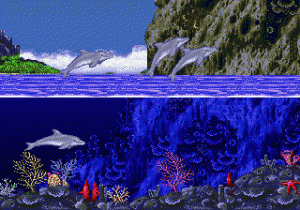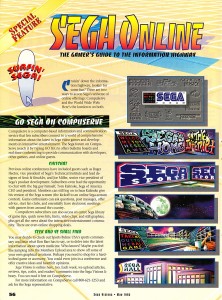 Most people who work in the video game industry will tell you that it’s rare to spend an entire career doing one single thing. Often, people find themselves moving around different jobs within a company or between companies, and it’s this diversity of skills that makes a résumé attractive to employers. Those who can multi-task are sure to go far.
Most people who work in the video game industry will tell you that it’s rare to spend an entire career doing one single thing. Often, people find themselves moving around different jobs within a company or between companies, and it’s this diversity of skills that makes a résumé attractive to employers. Those who can multi-task are sure to go far.
Kristin Harvey is a great example of that truth. Starting as an illustrator, she eventually found herself designing Sega of America’s website back when the Internet became a mainstream thing. The journey between these two fields was a long and engaging one, and Harvey found herself wearing many hats along the way. Currently, she works full-time as a Senior Creative Designer for ITX corp, designing complex UX/UI solutions for web and mobile applications. She is also a painter in her spare time and promotes her work through her website.
Ms. Harvey was kind enough to talk to Sega-16 about her time in the video game industry, specifically at Sega of America.
Sega-16: How did you get your start at Sega?
Kristin Harvey: As a senior at the Academy of Art University in San Franciso, I went to the job board looking for some part time illustration jobs and came across a post from Mediagenic looking for illustrators interested in video game design. This was at the start of computer graphics design, so they were just looking for talented illustrators willing to learn computer graphics. I sent samples of my work and was hired to work on Leather Goddesses of Phobos II. I contributed illustrations for backgrounds and some animation work.
Mediagenic eventually became Activision and moved to LA. I didn’t want to move from the Bay Area and soon found out what a small community video games was – at the time – and was told by others who did not go along for the move to stick around and offers would come. Soon I was working for Maxis on Sim products and then eventually Sega, hired by the art director I worked with at Maxis. It was much easier then, because the technology was so new that it was hard to find designers with the solid artistic foundations combined with computer graphic skills, so word spread fast if you had the skills and on-the-job training was always offered.
Sega-16: You did a lot of different types of art while at Sega, including background illustration, character art, and animation. Was there one you preferred over the others? If so, why?
Kristin Harvey: Background Illustration and style design, absolutely. I had gone to school for illustration and was always drawing and painting throughout my childhood. It was a natural fit. That I was able to learn computer graphics design while on the job was a fluke, really. Once I got a handle on the software and tools of the industry it remained the best fit because I had the foundational skills of color theory, composition, staging and drawing and painting that could be applied to bring the digital artwork to life in a way computer artists who may know the software but had no formal artistic training could not. While I did some limited character art and animation, they were never my strongest skill set, or where my interest lied.
Sega-16: What did a day as an illustrator at Sega entail (in general)? Did you have a specific space at Sega to work or did you work from home?
 Kristin Harvey: I always worked in the corporate environment, although our offices at SegaSoft were quite a fun design! At that time, affordability of the tools was an issue, so it was rare that someone could afford a workstation at home that could run the software we used. It was often the typical cube farm environment, but because we were all learning, we were always engaged in conversation and feedback for whatever project we were working on, and Nerf Wars occurred daily. Since I started as a graphic artist, my day was mostly a project meeting and project work. As I moved into more management and art direction, there were more meetings, less graphics work. Regardless of what I was doing, the environment and camaraderie were heady. We all felt like we were part of something very special, and at the time, we were.
Kristin Harvey: I always worked in the corporate environment, although our offices at SegaSoft were quite a fun design! At that time, affordability of the tools was an issue, so it was rare that someone could afford a workstation at home that could run the software we used. It was often the typical cube farm environment, but because we were all learning, we were always engaged in conversation and feedback for whatever project we were working on, and Nerf Wars occurred daily. Since I started as a graphic artist, my day was mostly a project meeting and project work. As I moved into more management and art direction, there were more meetings, less graphics work. Regardless of what I was doing, the environment and camaraderie were heady. We all felt like we were part of something very special, and at the time, we were.
Sega-16: Were you given specific criteria for your art, or did you have freedom to interpret and create?
Kristin Harvey: When I first started, there was much more direction or criteria. Once my contributions were shown to be of value, I gained more freedom. This was true, of course, for those products that were original content to Sega, such as Ecco the Dolphin and numerous in-house experiments. When I worked with licensed brands, the opposite was true. Often, we were given a brand style guide, and we had to stick to it. With the illustration work I did for the PICO system, this was a real growth opportunity. To be able to study a style enough to learn how it was executed and mimic it to a perfection that allowed brand approval allowed me to gain the versatility as an artist that has worked well for me in my ongoing career. I learned from the artwork of Disney and Jim Henson Studios, just for starters.
Sega-16: You illustrated games like Ecco the Dolphin (Sega CD) and Kolibri (32X), games that are known for their art styles. Were you shooting for a specific look for these particular games, or did it simply evolve over time?
Kristin Harvey: First, I’ll say my involvement in these games was early in the process, and the visuals evolved by the actual production artists were often breathtaking compared to anything I had done. But since I was onsite with producer Ed Annunziata, we were able to work collaboratively on initial sketches and designs, so he had something to show the digital designers which they could interpret and enhance. Ed was a fan of my illustration work, and for that I’ll be eternally grateful because I had the opportunity to do some of the original sketches of his fantastic ideas. You could consider what I did on Ecco more along the lines of “mood boards” and my work on Kolibri was just on the game manual.
Sega-16: Was illustrating on the Sega CD and 32X any different that on the Genesis in regards to tools, approach, etc.?
Kristin Harvey: I only worked on systems up to the Sega CD. By the time 32X was out, I was already into more management of freelance style and storyboard artists. But, I can say absolutely that from the Genesis games to the Sega CD, the tools and process evolved greatly. With Genesis, you had just so many characters with which to build an engaging world. We had to concern ourselves with character count constantly, and it could be quite frustrating while at the same time challenging. How cool can I make this with these few puzzle pieces? With the Sega CD, first person views and interactions, bitmaps and working in Photoshop instead of Dpaint exploded the creative opportunities. File size vs. image quality was still a constant concern, but we were getting closer to the beautiful backgrounds seen today.
Sega-16: What was your role as an internal support artist for third party companies?
Kristin Harvey: Primarily, it was asset gathering, direction and then quality assurance of artwork to brand or license match. Sometimes, we’d get a build where one element just wasn’t working so we’d do some mock-ups or animation tweaks to give the third party designers more direction. Other times, we created initial sketches or ideas that producers could then use to provide guidance. Most often, it involved licenses or brands. The Sega label was responsible for assuring that what was submitted for approval met the brand guidelines or standards before it was submitted.
Sega-16: You hired and managed other design artists while at Sega. What was that like?
Kristin Harvey: It is always a challenge to manage people, especially creative ones. There is a lot that goes with that role that is difficult or boring. However, it was a real joy to scout for freelancers, find the right style or skill set or help an on-staff artist grow their skills. I’m a multi-tasker by nature, so having a handle on multiple projects at any given time so you could provide the appropriate direction was something I enjoyed. But, having been and still working sometimes as a designer on projects made it hard to remove myself from the direction I provided. In other words, those moments of “I wouldn’t do it this way” had to be put aside for ” how can we get to the best outcome with this designer?” While I am no longer interested in the management side of design work, I learned so much from every artist I managed or worked with, I’d never trade that experience.
 Sega-16: How did you move on to building Sega’s first website? Were you looking for new challenges, or was it something that wasn’t planned?
Sega-16: How did you move on to building Sega’s first website? Were you looking for new challenges, or was it something that wasn’t planned?
Kristin Harvey: It wasn’t planned. At the time, and many people would just laugh at this, it was “hey, look at this cool new thing! It’s THE WEB! Can you make me some graphics so I can make this look better?” This being said by many different people at the time, from techs to producers. So, it was a very organic experience, and because it was an internal experiment, it came through internal support creative, and I had the time in my schedule. The first Sega website was one HUGE image map with a warped Cool World-style I was into at the time. It was a funky little city where an urban sandlot was the “Sega Sports” link, the corner arcade was “Our Games” and an elevated subway with graffiti was the “Get to Know Us” link, etc. It was soon outdated and considered hilarious, but at the time it was the coolest thing any of us had seen. I still have that original illustration in my art studio.
Soon after, we designed and built an intranet, and that’s where my real HTML skills were developed, using simple text! Back then, my illustration skills went a long way to bring digital art to life and take the viewer into the screen in a way that was unique. What is so funny is how much I’ve had to “unlearn” that along the way in order to simplify my designs for the technical requirements and best performance in today’s technology. For awhile there, every website I designed was a huge image map. Here again, I was fortunate enough to work with skilled designers who taught me the design principles I never learned as an Illustration student.
Sega-16: Which of the games that you worked on do you remember most fondly? Why?
Kristin Harvey: Ecco first, for it’s sheer beauty and the advancements it represented at the time. Ed Annunziata is a fantastic human with endless creative energy. Jurassic Park for the overall experience. The ultimate game was pretty good for its time, but what I found over the years was that the smaller game companies always had better output than on-staff teams at big publishers. I think it was simply because they were hungrier and more agile in their approaches outside of a corporate environment.
But for me, that time at Sega involved a trip to Stan Winston Studios to see the actual Raptor costumes and gigantic T-Rex animatronics, seeing and holding original movie artwork by Flash and storyboard artists, meeting and witnessing the famous paleontologist Bob Bakker dissect a chicken to show us how dinosaurs moved, going to the Lucasfilm studios to see cutting edge 3D graphics software and animations, learning about (at the time) blue screen technologies for seamless integration between live action and computer generated special FX, hosting life drawing workshops in our amazing blue screen studio, being a few feet away from Michael Jackson when he came to SegaSoft to visit our brand new sound studio designed by Spencer Nilsen… this is what I meant by the heady days of Sega of America. What I learned, what I was exposed to, I just can’t be thankful enough. It was an awesome time and a most serendipitous start to what has been a fulfilling career.
Our thanks to Ms. Harvey for sharing her Sega experiences with us!

Recent Comments